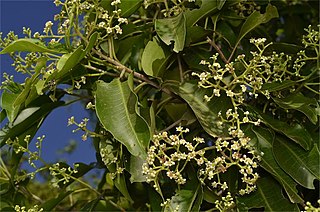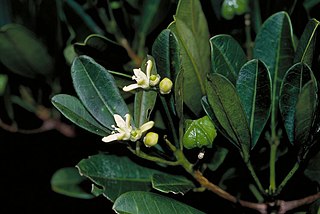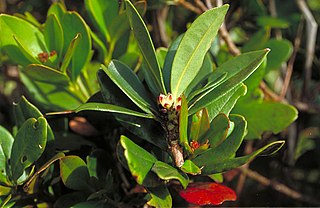
Geijera salicifolia, commonly known as glasswood, green satinheart or scrub wilga, is a species of shrub or tree in the family Rutaceae and is native to Australia, New Guinea and New Caledonia. It has narrow elliptic to egg-shaped leaves, small white flowers in loose groups and oval to more or less spherical fruit, each containing a shiny black seed.

Acronychia littoralis, commonly known as the scented acronychia, is a species of small tree that is endemic to eastern coastal Australia. It has simple, glabrous, elliptic to egg-shaped leaves, small groups of yellow flowers and egg-shaped to more or less spherical creamy-yellow fruit.

Acronychia baeuerlenii, commonly known as Byron Bay acronychia, is a species of rainforest shrub or small tree endemic to eastern Australia. It has simple, glabrous leaves, small groups of flowers and fleshy oval fruit.

Medicosma cunninghamii, commonly known as pinkheart or bonewood, is a species of shrub or small tree in the family Rutaceae and is endemic to eastern Australia. It has simple, narrow oblong to lance-shaped leaves and small white or cream-coloured flowers arranged in small groups.
Zieria obovata is a plant in the citrus family Rutaceae and is endemic to Queensland. It is a small, open shrub with leaves composed of three leaflets, and with up to three cream-coloured to pale pink flowers with four petals and four stamens. It usually grows on steep, rocky slopes in wet open forest.

Boronia excelsa is a plant in the citrus family Rutaceae and is endemic to a small area in Far North Queensland. It is an erect shrub with woolly-hairy branches, simple, stalkless, more or less hairless leaves, and pink to white, four-petalled flowers.

Acronychia chooreechillum, commonly known as mountain aspen, is a species of shrub or small rainforest tree that is endemic to north-eastern Queensland. It has mostly trifoliate leaves with elliptic to egg-shaped leaflets on stems that are more or less cylindrical, flowers in small groups in leaf axils and fleshy, egg-shaped or elliptical fruit.

Acronychia crassipetala, commonly known as crater aspen, is a species of small rainforest tree that is endemic to north-eastern Queensland. It has simple, elliptic to egg-shaped leaves on cylindrical stems, flowers in small groups, and fleshy, more or less spherical fruit.
Acronychia eungellensis, commonly known as Eungella aspen, is a species of small rainforest tree that is endemic to a restricted area in east-central Queensland. It has simple, elliptic leaves on cylindrical stems, flowers in small groups in leaf axils, and fleshy fruit that is elliptic to egg-shaped in outline.

Acronychia imperforata, commonly known as Logan apple, Fraser Island apple, or green tree, is a species of rainforest shrub or small tree that is endemic to north-eastern Australia. It has simple, elliptical to egg-shaped leaves, small groups of yellowish or creamy white flowers and fleshy spherical to oval fruit.

Acronychia parviflora is a species of shrub or small rainforest tree that is endemic to north-eastern Queensland. It has simple, egg-shaped to elliptical leaves, flowers arranged singly or in small groups in leaf axils and fleshy, more or less spherical fruit.
Medicosma elliptica, commonly known as Bulburin medicosma, is a species of shrub or small tree in the family Rutaceae and is endemic to a restricted area of Queensland. It has elliptical leaves and white flowers borne singly or in small groups in leaf axils.

Medicosma fareana, commonly known as white aspen, is a species of rainforest small tree in the family Rutaceae and is endemic to north Queensland. It has elliptical leaves and white or cream-coloured flowers borne singly or in small groups in leaf axils.
Medicosma forsteri is a species of small tree in the family Rutaceae and is endemic to a restricted area of Queensland. It has elliptical leaves and cream-coloured flowers borne singly or in small groups in leaf axils.

Medicosma glandulosa is a species of shrub or small tree in the family Rutaceae and is endemic to far north Queensland. It has elliptical to egg-shaped leaves and flowers that are white with red tips or cream-coloured, borne singly or in small groups in leaf axils.
Medicosma heterophylla is a species of small tree in the family Rutaceae and is endemic to a restricted area of far north Queensland. It has simple and trifoliate, elliptical leaves and leaflets, and cream-coloured to pink or reddish flowers borne singly or in small groups in leaf axils.
Medicosma mulgraveana is a species of small tree in the family Rutaceae and is endemic to a restricted area of far north Queensland. It has mostly trifoliate leaves with elliptical to egg-shaped leaflets and white flowers borne in small groups in leaf axils.

Medicosma sessiliflora is a species of shrub or small tree in the family Rutaceae and is endemic to far north Queensland. It has simple elliptical to egg-shaped leaves with the narrower end towards the base and cream-coloured flowers borne singly or in small groups in leaf axils.
Melicope affinis is a species of shrub or tree in the family Rutaceae and is endemic to Queensland. It has trifoliate leaves and small greenish white flowers borne in panicles in leaf axils.

Melicope broadbentiana, commonly known as false euodia, is a species of shrub or tree in the family Rutaceae and is endemic to Queensland. It has simple leaves, trifoliate leaves or both, and small white flowers borne in short panicles in leaf axils.













